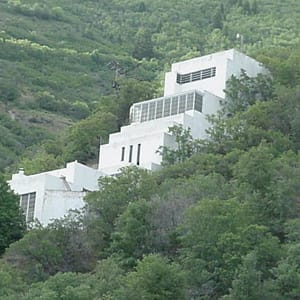It seemed that as more of Bishop Koyle's prophecies were fulfilled, the more opposition resulted. A few of these, not necessarily the greatest, will be considered here. Some of these prophecies and their fulfillment were witnessed by the author, Ogden Kraut, who worked with Bishop Koyle at the Dream Mine for two years.
World War I
Ten years before it happened, Bishop Koyle foretold Word War I. He also said the 145th Field Artillery, composed of mostly Mormon boys, would not see combat. Many parents felt comforted by his prediction, but when the newspapers carried headlines of the 145th in action, Fred Squires went to the Bishop showing him the paper. The Bishop said it was a lie, and told him that by the time the 145th would reach the front lines, the war would be over. Fred was holding a paper with the date November 11, 1918. By the time Fred arrived back in Salt Lake City, the armistice had been announced. The 145th did not see combat!
Men and Money at the Mine
Another impressive prediction was that men and money would always be provided at the mine when needed. From 1914 to the day the Bishop died in 1949, week after week, month after month, year after year, men and money were amazingly available. Regardless of wars, depressions, inflations and persecutions, the mine was always able to meet its operational needs.
The Water Ditch
John Koyle instructed the miners to dig a small ditch along side of the rail track in one of the main tinnels. He said it was to take care of the water they would hit at 2,200 feet inside the mine. He even told them the day they would strike the water. At 2,200 feet on the day predicted, they struck water, filling the small ditch which was just large enough to accommodate the flow of water to the outside. Throughout mining activities, many landmarks were described by Bishop Koyle before they were reached.
The Powder Mill
"One of Koyle's more outlandish predictions came years ago when, pointing across the sagebrush desert to a desolate spot, he said, 'There'll be a big manufacturing plant right there someday.' The place was isolated, on rocky ground, above the irrigation level, far from human habitation. Too, the valley had hundreds of better sites. Came the war, and today a powder mill stands on the spot. Isolation is a prime requisite for a powder mill, and the location is ideal." ("Time and the Dream Mine", by Samuel W. Taylor, Esquire Magazine, Nov 1943)
Church Reopens the Mine
The two Nephites had told Bishop Koyle the mine would soon be shut down, but that the same powers that closed it would re-open it. Six months later the Bishop and his workers were threatened with excommunication from the church if they continued to labor on that mountain. So they shut it down, and it was closed for six years. The Heber J. Grant, saw an unpaid bill at ZCMI for $2,000 incurred by the mine operators. Learning that by re-opening the mine it would clear up that bill, he ordered it re-opened.
The 1929 Depression
In 1929 the Bishop told Henry Gardner, his Stake President and owner of a bank in Spanish Fork, that four months from that date there would be a terrible financial crash in the nation. When four months went by, President Gardner called the Bishop and said his dream about the depression had not come to pass. The Bishop reminded him there was still one more day left. The next day was October 29th, the day of the famous stock market crash.
Muddy Water In Salt Lake
Norman Pierce, in his book "The Dream Mine Story", mentioned a prophecy he had heard from Bishop Koyle: About this time Bishop Koyle had another of his same prophetic dreams which I heard him relate, saying, "It looks like it won't be long now before we'll be having some of the big troubles we've been expecting. I saw in a dream the other night that muddy water would flow in the streets like rivers in almost every community from one end of the state to the other. When it comes, it's going to cause a lot of trouble for a lot of people around here. It will be the beginning of really big troubles." (p.90, 1958) In 1983, rain and fast melting snow inundated many communities in the state of Utah. Water literally ran down the streets of cities from one end of the state to the other. Some small towns were abandoned until the water receded. Almost every county asked for federal emergency assistance. "The Agriculture and Health Committee was told that Utah's farms and ranches have sustained an estimated $57.7 million loss." (Salt Lake Tribune, "Utah Floods", p. 62) There were $63 million in road damage in the state. The total estimate for flood damages that year amounted to over $200 million. Another of John Koyle's prophecies was amazingly fulfilled. Will we see a dual fulfillment?
End of World War II
Shortly after the Japanese bombed Pearl Harbor in 1941, Dr. Brooksby of Fredonia, Arizona, invited Bishop Koyle to his home for a few days. One morning the Bishop came out of his bedroom and announced that the Lord had shown him in a dream that the war would end by August 27, 1945. (Ogden Kraut personally heard it mentioned from Dr. Brooksby.) Lee Goates of the Deseret News heard of this prophecy and in disbelief mentioned it in a sports column. On August 6th and 7th, 1945, the atom bombs were dropped on Hiroshima and Nagasaki. By the 27th, the Japanese had agreed to surrender.
Kennecott Copper and Geneva Steel
The Bishop told many of us at the mine that some day Kennecott Copper Mine and Geneva Steel would shut down and the Tintic Mining area would be almost at a standstill. We assumed this would happen because of the great trouble in the nation when everything would be in the same condition. However, in 1985, the Kennecott Mine shut down for over a year, and at the same time Geneva Steel also closed. When this happened, I asked a friend of mine who lived in Eureka what was going on in the Tintic Mining area. He replied, "almost everything is shut down except the Sunshine Mine, and it isn't doing much."
Joseph Fielding Smith's Conference Talk
One day J. Golden Kimball received word that Bishop Koyle wanted to see him as soon as possible, so he drove right down to the mine. Koyle immediately got into the subject that was causing him considerable distress by saying, "Golden, the Lord showed me in a dream that Joseph Fielding Smith is preparing a conference sermon that is against the Dream Mine--and the Lord doesn't want him to deliver it. I want you to go up there and tell him not to give that sermon." "Not me," replied Golden. "I'm not going to put my head in the lion's mouth." Koyle grabbed Kimball by the coat collar and said, "Golden, God hates a coward." He looked a little sheepish and replied, "All right, Bishop, I'll tell him, but I don't have any faith that it will do any good." The Bishop smiled and retorted, "Don't worry; I'll take care of the faith." Kimball returned to Salt Lake City and went directly to Joseph Fielding Smith's office. Smith was at his desk, so Golden walked over and said, "Brother Smith, you're not supposed to deliver that conference sermon against the Dream Mine." Smith jumped up and shouted, "How did you find out about that sermon? I haven't told anyone!" Golden replied, "Well, the Lord knows, and he told Bishop Koyle about it." When conference came, Joseph Fielding Smith delivered a sermon, but made no mention of the Dream Mine. (Bishop Koyle's Relief Mine, Kraut, p. 105)
The greatest of John Koyle's prophecies is yet to be fulfilled. It is regarding the coming in of the mine. The question most often asked is, "When will it be?" According to Bishop Koyle, it will be when this nation is in great peril. There will be three-inch headlines in newspapers reporting a great disaster. In the same paper there will be a small notice mentioning that the Dream Mine was making its first shipment of ore.
This text has come from the writings of Ogden Kraut. To see a listing of all his published works, please visit www.ogdenkraut.com

